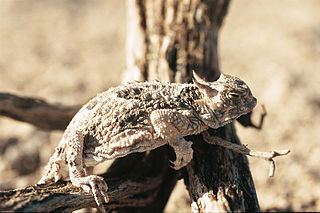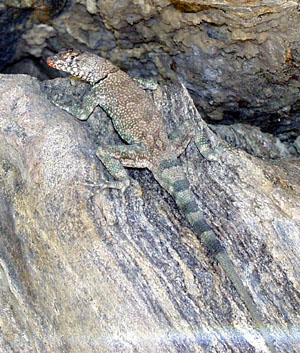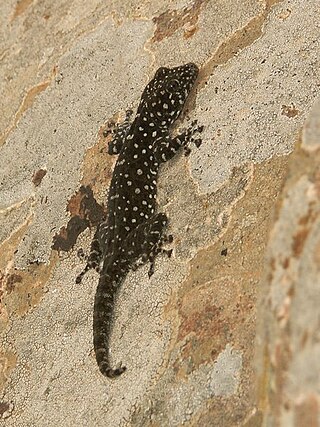
The Phrynosomatidae are a diverse family of lizards, sometimes classified as a subfamily (Phrynosomatinae), found from Panama to the extreme south of Canada. Many members of the group are adapted to life in hot, sandy deserts, although the spiny lizards prefer rocky deserts or even relatively moist forest edges, and the short-horned lizard lives in prairie or sagebrush environments. The group includes both egg-laying and viviparous species, with the latter being more common in species living at high elevations.

The zebra-tailed lizard is a species of lizard in the family Phrynosomatidae. The species is native to the Southwestern United States and adjacent northwestern Mexico. There are nine recognized subspecies.

The greater earless lizard is the only species in the monotypic genus Cophosaurus. It is closely related to the smaller, lesser earless lizards and other species in the genus Holbrookia, and in fact was placed in that genus and referred to Holbrookia texana from 1852 into the 1970s. Earless lizards lack external ear openings, an adaptation to burrowing in the sand, as are the recessed lower jaw and flared upper labial scales. Greater earless lizards are sexually dimorphic, males grow larger and are more colorful than females, exhibiting pink and green colors that are particularly bright in the breeding season. Two bold black bars mark the lateral region of males but are greatly reduced and vague, or occasionally entirely absent in females.

Spiny lizards is a common name for the genus Sceloporus in the family Phrynosomatidae. The genus is endemic to North America, with various species ranging from New York, to Washington, and one occurring as far south as northern Panama. The greatest diversity is found in Mexico. This genus includes some of the most commonly seen lizards in the United States. Other common names for lizards in this genus include fence lizards, scaly lizards, bunchgrass lizards, and swifts.

Urosaurus is a genus of lizards, commonly known as tree lizards or brush lizards, belonging to the New World family Phrynosomatidae.

Philochortus is a genus of lizards of the family Lacertidae. Species of this genus are distributed in Egypt, Algeria, Libya, Mali, Niger, Ethiopia, Djibouti, Eritrea, Somalia, Kenya, Yemen, and Saudi Arabia.

Urosaurus ornatus, commonly known as the ornate tree lizard, is a species of lizard in the family Phrynosomatidae. The species is native to the southwestern United States and northwestern Mexico. The species, which was formerly called simply the "tree lizard", has been used to study physiological changes during the fight-or-flight response as related to stress and aggressive competition. Its life history and costs of reproduction have been documented in field populations in New Mexico and Arizona. This species has been fairly well studied because of its interesting variation in throat color in males that can correlate with different reproductive strategies,

The granite spiny lizard is a species of lizard in the family Phrynosomatidae.

The sagebrush lizard or sagebrush swift is a common species of phrynosomatid lizard found at mid to high altitudes in the western United States of America. It belongs to the genus Sceloporus in the Phrynosomatidae family of reptiles. Named after the sagebrush plants near which it is commonly found, the sagebrush lizard has keeled and spiny scales running along its dorsal surface.

Phyllodactylus xanti is a species of lizard in the family Phyllodactylidae. It is endemic to northwestern Mexico. It is also known as the leaf-toed gecko or Raza Island leaf-toed gecko when referring to the subspecies from the Isla Rasa; at present, there are altogether four recognized subspecies, while several more have been recognized previously.

Petrosaurus mearnsi, also called the banded rock lizard, is a species of lizard in the family Phrynosomatidae. The species is native to western North America.

Holbrookia maculata, commonly known as the lesser earless lizard, is a species of lizard in the family Phrynosomatidae. The species is native to the southwestern and central United States and northern Mexico. There are eight recognized subspecies.

Sceloporus merriami, commonly known as the canyon lizard, is a species of lizard in the family Phrynosomatidae. The species is native to the south-western United States and northern Mexico.

Ptyodactylus puiseuxi, common names Israeli fan-fingered gecko and Levante fan-fingered gecko, is a species of lizard in the family Phyllodactylidae. The species is endemic to the Middle East.

Urosaurus nigricauda is a species of lizard. Common names for this species include the Baja California brush lizard, black-tailed brush lizard, and small-scaled tree lizard. Its range includes southern California, Baja California, and nearby Pacific islands.

Slevin's bunchgrass lizard is a species of lizard in the family Phrynosomatidae. The species is indigenous to the southwestern United States and adjacent northern Mexico.

Sceloporus uniformis, also known as the yellow-backed spiny lizard, is a reptile of the family Phrynosomatidae. It is native to the Mojave and Great Basin deserts. Until recently, it was considered to be a subspecies of Sceloporus magister.

Aristelliger praesignis, is a species of gecko, a lizard in the family Sphaerodactylidae. The species is endemic to Jamaica and the Cayman Islands.

Sphaerodactylus richardsonii, also known commonly as Richardson's least gecko or the northern Jamaica banded sphaero, is a small species of lizard in the family Sphaerodactylidae. The species is endemic to Jamaica.




















